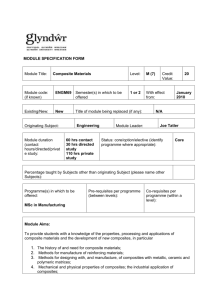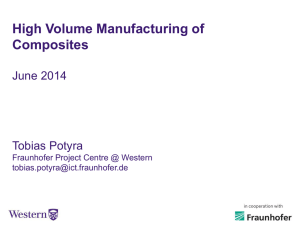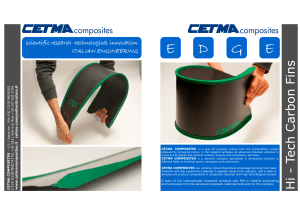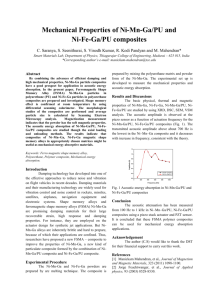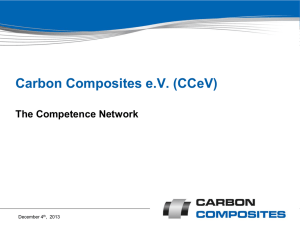An evaluation of morphed composites produced from a
advertisement
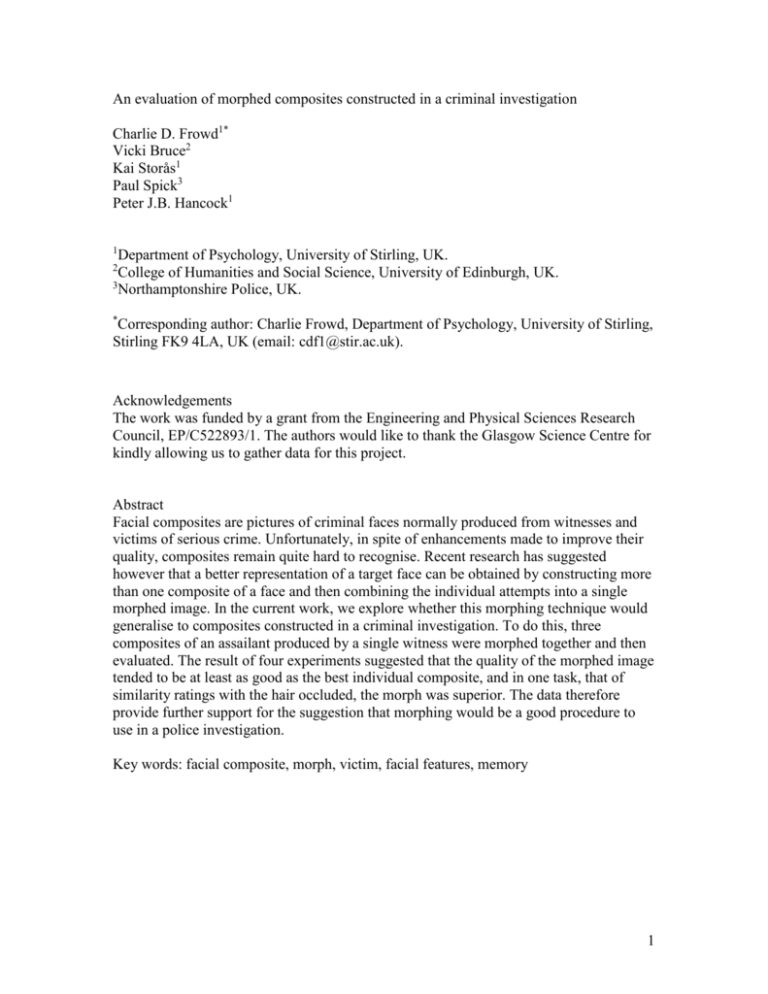
An evaluation of morphed composites constructed in a criminal investigation Charlie D. Frowd1* Vicki Bruce2 Kai Storås1 Paul Spick3 Peter J.B. Hancock1 1 Department of Psychology, University of Stirling, UK. College of Humanities and Social Science, University of Edinburgh, UK. 3 Northamptonshire Police, UK. 2 * Corresponding author: Charlie Frowd, Department of Psychology, University of Stirling, Stirling FK9 4LA, UK (email: cdf1@stir.ac.uk). Acknowledgements The work was funded by a grant from the Engineering and Physical Sciences Research Council, EP/C522893/1. The authors would like to thank the Glasgow Science Centre for kindly allowing us to gather data for this project. Abstract Facial composites are pictures of criminal faces normally produced from witnesses and victims of serious crime. Unfortunately, in spite of enhancements made to improve their quality, composites remain quite hard to recognise. Recent research has suggested however that a better representation of a target face can be obtained by constructing more than one composite of a face and then combining the individual attempts into a single morphed image. In the current work, we explore whether this morphing technique would generalise to composites constructed in a criminal investigation. To do this, three composites of an assailant produced by a single witness were morphed together and then evaluated. The result of four experiments suggested that the quality of the morphed image tended to be at least as good as the best individual composite, and in one task, that of similarity ratings with the hair occluded, the morph was superior. The data therefore provide further support for the suggestion that morphing would be a good procedure to use in a police investigation. Key words: facial composite, morph, victim, facial features, memory 1 Facial composites are visual likenesses of a face and are normally produced from witnesses and victims of serious crime. To construct such an image, the traditional approach is for a witness (or victim) to describe the appearance of a suspect and select facial features to match. Composites are often presented on TV crime programmes and in the newspapers in the hope that the face will be recognised by someone familiar with the suspect. In spite of recent technological advancements to improve the identification of suspects, such as DNA evidence and CCTV, facial composites remain an important part of a police investigation. Over the last 30 years or so, research has been instrumental in improving the identifiability of facial composites, largely through enhancements to the technology (Davies, 1983; Davies, Shepherd, Shepherd, Flin & Ellis, 1986; Frowd, Hancock & Carson, 2004; Frowd et al., submitted; Frowd, Bruce, Ross, McIntyre & Hancock, under revision) and the procedures used with witnesses (Frowd, McQuiston-Surrett, Kirkland & Hancock, 2005c; Malpass, Lavigueur & Weldon, 1981; Shepherd & Ellis, 1996). Nevertheless, composites vary considerably in quality and in general their recognition is far from ideal (Brace, Pike & Kemp, 2000; Bruce, Ness, Hancock, Newman, & Rarity, 2002; Davies, van der Willik, & Morrison, 2000; Frowd et al., 2004, 2005a, 2005b; Frowd, Bruce, McIntyre, & Hancock, in press, Frowd et al., submitted, under revision; Koehn & Fisher, 1997; Kovera, Penrod, Pappas & Thill, 1997). Bruce et al. (2002) describe a promising approach in which the identification of a target face was improved using a ‘morphed’ composite, an image obtained by averaging together a number of individual composites constructed of this same target. In their first experiment, laboratory-witnesses constructed composites from unfamiliar and famous targets, both from memory and with the target present during construction using the UK PRO-fit system. Morphs of two composites (2-morph) and morphs of four composites (4morph) were then prepared. Similarity ratings of likeness and identification from a 6-item line-up indicated that the 4-morph was of better quality than both the 2-morph and the worst rated composite. Crucially, the 4-morph performed the same as the best rated individual composite. This finding applied to both unfamiliar and celebrity targets and was replicated in a second experiment using a more realistic design. In a real case, it would not be known which of several composites was the best. Morphing resolves this uncertainty, by producing one image that is on average as good as the best. Bruce et al. argue that a composite morph provides a representation which is closer to the prototype or veridical image of a target. They suggest that in criminal investigations involving multiple witnesses of the same assailant, it might be useful for each person to construct a composite and permit the production of a morph. Until recently, the police have been wary about allowing more than one composite to be produced since they would not know which composite to release to the media: They would be reluctant to publish all the images since composite quality tends to vary considerably across witnesses and different attempts at the same target may look like quite different people. These issues appear to be avoided by publishing a morph, an image which will tend to emphasise the facial characteristics on which the witnesses agree and which are therefore most likely to be accurate. The Bruce et al. study presents good evidence for the benefit of morphing, but the composites were nonetheless constructed in the laboratory and therefore ecological validity may be limited. The current work explores the potential of morphing composites 2 that were constructed during a genuine criminal investigation. The relevant case was called Operation Mallard and concerned a series of sexual assaults which occurred in southern England. Three composites were produced from the victim of the last of the assaults. While none of these led to the name of the assailant being reported to the police, a conviction based on DNA matching was recently successful. In the current paper, we investigate the quality of a morph produced from the composites in the Mallard case. This was achieved by evaluating the composites and the resultant morph with ratings of likeness, an identification task and a standard composite matching task (sorting), in conjunction with a photograph of the convict. It was expected that the quality of the morph would be at least as good as the best individual composite, as found by Bruce et al. (2002). Operation Mallard Operation Mallard was a UK criminal investigation involving three serious indecent assaults by a white male in his mid-to-late twenties in Southern England between 1998 and 2000. The first two incidents occurred in 1998 in Farnborough, Hampshire, and St. Neots, Cambridgeshire. The third occurred in Bozeat, Northamptonshire. A three-quarter view sketch was constructed in the Cambridgeshire attack, and three full-face composites were constructed in the Northants case. A sketch was constructed first by the victim of the Bozeat incident. Following a public appeal for information, which unfortunately did not lead to a conviction, a composite using the E-FIT system was also attempted. One problem with constructing these composite was a difficulty in recalling the assailant’s hair. About a year later, however, the victim identified an appropriate hairstyle (first on a passer-by in the street, then on TV), and an updated sketch was prepared for the hair. Using this hairstyle, a third composite was constructed using the EvoFIT system and another public appeal made. These composites are shown in Figure 1. While none of the public appeals were successful, the assailant was recently identified by familial DNA (a family member was listed on the National DNA database). Figure 1. The Sketch, E-FIT and EvoFIT constructed of the ‘Beast of Bozeat’. A recent photograph of the assailant is far right. The Bozeat case is slightly unusual in that the same person constructed more than one composite of the assailant: it is more normal for each composite to be constructed by 3 a different witness (and there are specific UK guidelines for when this is permissible). This crime does however provide a good opportunity to investigate the quality of a morph from composites produced in a real case. As mentioned above, a sketch and an E-FIT were produced in this case. These two techniques require witnesses or victims to describe a suspect’s face and then select individual facial features. Sketches are normally constructed using pencils or crayons and E-FITs with the aid of a computer program (E-FIT is very similar to another UK system, PRO-fit). A composite was also produced using EvoFIT, a system in development at Stirling University (Frowd et al., 2004, 2005b, submitted). Rather than selecting individual features, this technique focuses on complete faces, and users repeatedly select from a small number of faces, which are then ‘bred’ together to produce more faces, and a composite is ‘evolved’ over time. Method Design Four standard tasks commonly used to evaluate composites were administered on the Bozeat composites and morph. Subjective likeness ratings were first collected, obtained in the presence of a photograph of the offender. Given that the composites and morphs have fairly long hair, but the hair in the photograph was short, further ratings were conducted with the hair removed. Likeness ratings using these ‘internal feature’ composites provide a measure of composite quality for the most important part of a face for identification, that is, the inner face (e.g. deHaan & Hay, 1986; Ellis, Shepherd & Davies, 1979; Frowd et al., in press). An identification task was administered next and involved selection from an array of six faces (the assailant’s face plus five other similarlooking faces). The final task was composite sorting, which involved participants matching a set of composites and morphs, including those from the Bozeat case, to their respective targets. Sorting provides an approximate measure of feature quality as participants tend to compare features between composites and target faces (Frowd et al., 2005b). The design was within-subjects for composite type (sketch / E-FIT / EvoFIT / morph) for the four tasks administered except identification, which was between-subjects. Participants Participants were volunteers. They were sampled from staff and students at the University of Stirling for the likeness rating task of complete faces, and comprised of 5 males and 5 females from 17 to 22 years (M = 18.9 years, SD = 1.6); for all other tasks, participants were visitors to the Glasgow Science Centre. For ratings of internal composite features, there were 9 males and 9 females from 23 to 66 years (M = 38.7, SD = 10.5); for the identification task, there were 29 males and 32 females from 19 to 66 years (M = 37.1, SD = 13.6); and for the sorting task, there were 9 males and 12 females from 21 to 63 years (M = 38.1, SD = 10.3). 4 Materials Materials were the E-FIT, sketch and EvoFIT of the ‘Beast of Bozeat’, as seen in Figure 1, and a morph thereof. The morph was prepared using a standard software program, PRO-morph. This program was used to identify about 250 key locations around the facial features of each composite – hair, face shape, eyes, nose, mouth, etc. – and then to generate a single morphed image, as shown in Figure 2. The composites, morph, and a photograph of the assailant were printed in monochrome at approximately 6cm (wide) x 8cm (high) using a good quality printer, then cut into individual faces. Figure 2. Morph of the ‘Beast of Bozeat’ composites. Adobe Photoshop was used to remove the hair on both the composites and morph for the internal features rating task. To do this, Photoshop’s Elliptical Marquee tool was used to extract an oval shape containing the inner face, which was then cropped just above the brows to avoid hair. Five distracters or ‘foils’ for the identification task were selected (by the first author) to be visually similar to the assailant. The foils were unfamiliar faces in their midto-late twenties, were clean shaven and depicted with short, dark hair, and no spectacles. These faces were printed on an A4 sheet in two rows of three along with the assailant’s face, which was placed by random assignment in the middle of the top row. The sorting task involved an additional E-FIT, sketch and EvoFIT of a celebrity face whose appearance was similar to the assailant: short, dark hair; clean shaven; and no spectacles. These composites were taken from a recent research project (Frowd et al., 2005a) and each was made by a different participant-witness who looked at a photograph of the celebrity (who was not known to them) and produced a composite 2 days later. Procedures were used that broadly matched those of real witnesses and included a Cognitive Interview, to assist with recall (e.g. Geiselman, Fisher, MacKinnon & Holland, 1986), and open-ended construction sessions, to promote the best likeness (Frowd et al., 2005b). A morph of these composites was prepared as for the Bozeat composites. A photograph of the celebrity face was also used. Procedure 5 Participants were tested individually and told that they would be evaluating a set of facial composites. All tasks were self paced. For the two likeness rating tasks, the Bozeat composites and morph were laid out in front of the participants, along with the photograph of the assailant, and each person was asked to provide a likeness rating (1 = poor likeness / 7 = good likeness). The order of presentation was randomised for each person. For the identification task, participants were given either one of the composite faces or the morph (chosen at random) and were asked to select the most likely target face from the line-up. A total of 13 people inspected the morph, 15 inspected the E-FIT, 16 inspected the EvoFIT and 17 inspected the sketch. If participants did not identify the criminal from the line-up, they were requested to select another face. This was done to boost accuracy scores since the task is fairly insensitive when used with composites (Frowd et al., 2005a, in press). For the sorting task, the two target photographs (Bozeat and celebrity face) were laid out on the table and a pile containing the Bozeat and celebrity composites and morphs were given to participants. Participants were asked to match the composites to the target faces by placing each in a pile in front of the photographs. They were encouraged to match the composites in the order given but not to make exchanges once placed on the table. No mention was made as to the number of composites to be placed in each pile. The order of composites, morphs and target photographs was randomised for each person. Results Mean scores for the four tasks administered on the four different types of composite are shown in Table 1. Table 1. The mean performance of the composites and morph in the four tasks administered. Figures are out of 7 for Likeness ratings (1 = poor likeness / 7 = good likeness) and percent correct for Identification and Sorting; numbers in brackets are standard deviations. * = better than all other techniques in that task, p < .05. Task E-FIT EvoFIT Sketch Morph Overall Likeness rating: complete composites 1.6 (0.7) 2.3 (1.7) 3.9 (1.9) 3.6 (1.8) 2.9 Likeness rating: internal composite features 2.6 (1.6) 3.5 (1.5) 2.9 (1.6) 4.7* (1.3) 3.4 Identification (a) first choice only 20.0 25.0 41.2 30.8 29.2 33.3 25.0 70.6 76.9 51.5 66.7 90.5* 73.8 81.0 78.0 (b) first and second choices Composite sorting 6 Likeness ratings: complete composites. For the complete composites, likeness ratings were generally quite low overall, a mean of 2.9 out of 7, and were best for the sketch and the morph composites, followed by the EvoFIT and the E-FIT. Participant likeness ratings were subjected to a repeated-measures Analysis of Variance (ANOVA) and this was significant for composite type, F(3, 27) = 10.5, p < .001. Simple contrasts of the ANOVA revealed that the morph and the sketch did not differ significantly from each other, p > .1, but were both rated better than the other systems, p < .01. The effect size between the morph and the worst rated composite, the E-FIT, was very large, d = 1.4. A within-subjects t-test showed no significant difference between the EvoFIT and the EFIT, t(9) = 1.4, p > .1. Likeness ratings: internal composite features. Likeness ratings of the internal composite features were generally higher than those of complete composites (except sketch). This time, the morph was rated by far the best, with an average rating of nearly 5 out of 7. The ANOVA was again significant for composite type, F(3,51) = 7.1, p < .001, and simple contrasts confirmed the superiority of the morph, p < .05. The effect size, d, varied from 0.8 (EvoFIT) to 1.4 (E-FIT). Two further t-tests were conducted, one indicating that the EvoFIT was a little better rated than the E-FIT, t(17) = 1.9, p < .1, the other showing no difference between the E-FIT and the sketch, t(17) = 0.7, p > .1. Identification. Accuracy scores for initial selections made in the identification task were quite low overall (M < 30%) and did not approach significance by composite type using a non-parametric (Kruskal Wallis) ANOVA, X2(3) = 1.9, p > .1. Taking second choices into account substantially increased scores of the sketch and morph and the ANOVA now reached significance, X2(3) = 12.1, p < .01. Wilcoxon Signed Ranks tests (first and second choices) found the same pattern of results as for the likeness ratings (complete): the morph and the sketch were equivalent and best, Z = 0.4, p > .1, the morph was superior to the EvoFIT, Z = 2.7, p < .01, with a very large effect size, d = 1.2, and the EvoFIT was equivalent to the E-FIT, Z = 0.5, p > .1. Sorting. Unlike the other measures, sorting also involved composites and a morph of a celebrity target. In both sets of composites, the EvoFITs were sorted best and about 10% better than the next best technique, the morphs, while the E-FITs were last. Given a similar pattern of effects for both sets, and to increase statistical power, the data were collapsed over target and analysed using a Kruskal Wallis ANOVA. This found an approaching significant main effect of composite type, X2(3) = 7.2, p < .1. There was evidence that the EvoFITs were sorted better than all other types, Z < 1.9, p < .052, and that the E-FITs were sorted the same as the sketches, Z = 0.5, p > .1. One further test was carried out, which indicated that the morphs were sorted slightly better than the worst composites, the E-FITs, Z = 1.4, p < .1 (one-tailed). 7 General Discussion Laboratory research has reported that morphing composites of the same target face produces a representation that is at least as identifiable as the best individual composite (Bruce et al., 2002). In the current work, the potential of morphing was revisited using composites that were produced in a criminal investigation. The data found that the morph functioned well overall, emerging best for likeness ratings of internal features and joint best in both likeness ratings of complete faces and the identification task (first and second choices); only in the sorting task did the morph perform worse than another technique. Likeness ratings of complete composites and the morph were generally quite low, and this was perhaps caused by the presence of short hair in the assailant’s photograph but long hair in the composites and morph. Removal of the hair accordingly increased ratings by at least one point for all systems, except sketch, which curiously decreased by a similar amount. It is likely that the hair in the sketch is most like the assailant’s face, in both style and length, and therefore less improvement was gained when the hair was removed. In general, the likeness ratings indicated that the morph was as one of the best representations, as found by Bruce et al. (2002); the effect size was also very large compared with the worst composite. The morph was rated superior by internal features, the most important part for recognising a face (e.g. Ellis, et al., 1979). An evaluation of the composites and morph by naming would have been desirable, although it was not possible here, since the target is not generally known. Instead, arguably the next best measure was employed: identification via line-ups. Accuracy in this task did not differ significantly by composite type for first choices, due to generally poor performance, but when combined with second choices, the sketch and the morph emerged better than the E-FIT and EvoFIT, since people who chose one first tended to choose the other second. Thus, the techniques with the best (whole face) ratings, the sketch and the morph, also had the best performance in the identification task, and vice versa; this results also mirrors Bruce et al. Thus, both the identification and rating data favour the composite morph. The sorting task involved an E-FIT, a sketch and an EvoFIT constructed of a celebrity face. Of course, it would have been better were unfamiliar composites used throughout, though no such stimuli were available. While one might have expected participants to use different strategies to match composites of familiar and unfamiliar faces (e.g. Young, Hay, McWeeny, Flude & Ellis, 1985), research suggests otherwise (Frowd et al., in press). In addition, none of these celebrity composites were correctly named in the project from which they originated (Frowd et al., 2005a). Appropriately then, the same general pattern of results was found here for the Bozeat and celebrity sets. This time, the morphs were less successful (M = 81.0%). They were sorted significantly worse than the best technique, the EvoFITs (M = 90.5%), and only slightly better than the worst, the E-FITs (M = 66.7%). This result would seem to be sensible given that the task provides a rough measure of feature quality and that the morphs contained features that were an average of their constituent composites. Bruce et al. (2002) demonstrated a benefit for morphing using composites produced from different memories (i.e. from different participant-witnesses). They assumed that the morph was successful as a probe for similarity and recognition since 8 consistent parts of the composite would be reinforced, but less consistent parts would cancel out (assuming that any errors were uncorrelated). While the current work did not involve composites produced from different witnesses and victims, which would make an interesting study in itself, and one that we are investigating, composites were obtained from the same person, albeit over the course of a year, and a similar benefit was observed for morphing. While Bruce et al. used a single composite system throughout, PRO-fit, perhaps the morphing process here served to average out errors that were introduced by the composite systems themselves. It is clear that production systems are still unable to render likeness without error, since poor recognition of composites is observed even when construction is attempted with the target present (Brace et al., 2000; Bruce et al., 2002; Davies et al., 2000; Frowd et al., submitted; Laughery & Fowler, 1980). Therefore, morphing may alleviate in part some of the problems associated with the technology of composite production. This notion is consistent with findings using laboratory-produced composites from different systems (Ness, 2003). To conclude, in three out of the four tasks administered, the morphed composite functioned either the same as the best individual composite or better. This result supports the general finding of Bruce et al., but has the advantage that the composites were constructed under more realistic conditions. The data provides further support that morphing composites would be a beneficial procedure within the context of a criminal investigation. An additional implication of the work is that it may be worthwhile for a single witness to make more than one composite of the same assailant using different techniques. In this case, morphing may serve to reduce errors introduced from the production systems themselves. References Brace, N., Pike, G., & Kemp, R. (2000). Investigating E-FIT using famous faces. In A. Czerederecka, T. Jaskiewicz-Obydzinska & J. Wojcikiewicz (Eds.), Forensic psychology and law (pp. 272-276). Krakow: Institute of Forensic Research Publishers. Bruce, V., Ness, H., Hancock, P.J.B, Newman, C., & Rarity, J. (2002). Four heads are better than one: Combining face composites yields improvements in face likeness. Journal of Applied Psychology, 87, 894-902. Davies, G.M. (1983). Forensic face recall: the role of visual and verbal information. In S.M.A. Lloyd-Bostock and B.R. Clifford (Eds.). Evaluating witness evidence (pp. 103123). John Wiley & Sons Ltd. Davies, G.M., Shepherd, J., Shepherd, J., Flin, R., & Ellis, H.D. (1986). Training skills in police photofit operators, Policing, 2, 35-46. Davies, G.M., van der Willik, P., & Morrison, L.J. (2000). Facial Composite Production: A Comparison of Mechanical and Computer-Driven Systems. Journal of Applied Psychology, 85, 119-124. 9 de Haan, E. H., & Hay, D. (1986). The matching of famous and unknown faces, given either the internal or external features: A study on patients with unilateral brain lesions. In H. D. Ellis, F. Jeeves, F. Newcombe & A. W. Young (Eds.), Aspects of face processing (pp. 302-309). Dordrecht: Martinus Nijhoff. Ellis, H.D., Shepherd, J.W., & Davies, G.M. (1979). Identification of familiar and unfamiliar faces from internal and external features: some implications for theories of face recognition, Perception, 8, 431-439. Frowd, C.D., Bruce, V., McIntyre, A. & Hancock, P.J.B. (in press). The relative importance of external and internal features of facial composites. British Journal of Psychology. Frowd, C.D., Bruce, V., Ness, H., Thomson-Bogner, C., Peterson, J., Mcintyre, A. & Hancock, P.J.B. Parallel approaches to composite production. Submitted to Ergonomics. Frowd, C.D., Bruce, V., Ross, D., McIntyre, A. & Hancock, P.J.B. (under revision). An application of caricature: how to improve the recognition of facial composites. Visual Cognition. Frowd, C.D., Carson, D., Ness, H., McQuiston, D., Richardson, J., Baldwin, H., & Hancock, P.J.B. (2005a). Contemporary Composite Techniques: the impact of a forensically-relevant target delay. Legal and Criminological Psychology, 10, 63-81. Frowd, C.D., Carson, D., Ness, H., Richardson, J., Morrison, L., McLanaghan, S. & Hancock, P.J.B. (2005b). A forensically valid comparison of facial composite systems. Psychology, Crime and Law, 11, 33-52. Frowd, C.D., Hancock, P.J.B., & Carson, D. (2004). EvoFIT: A holistic, evolutionary facial imaging technique for creating composites. ACM Transactions on Applied Psychology (TAP), 1, 1-21. Frowd, C.D., McQuiston-Surrett, D., Kirkland, I. & Hancock, P.J.B. (2005c). The process of facial composite production. In A. Czerederecka, T. Jaskiewicz-Obydzinska, R. Roesch & J. Wojcikiewicz (Eds.). Forensic Psychology and Law (pp. 140-152). Krakow: Institute of Forensic Research Publishers. Geiselman, R.E., Fisher, R.P., MacKinnon, D.P. & Holland, H.L. (1986). Eyewitness memory enhancement with the cognitive interview. American Journal of Psychology, 99, 385-401. 10 Koehn, C.E., & Fisher R.P. (1997). Constructing facial composites with the Mac-a-Mug Pro system. Psychology, Crime & Law, 3, 215-224. Kovera, M.B., Penrod, S.D., Pappas, C., & Thill, D.L. (1997). Identification of computer generated facial composites, Journal of Applied Psychology, 82, 235-246. Laughery, K., & Fowler, R. (1980). Sketch artist and identikit procedures for generating facial images, Journal of Applied Psychology, 65, 307-316. Malpass, R.S., Lavigueur, H., & Weldon, D. (1981) Guided memory in eyewitness identification, Journal of Applied Psychology, 66, 343-350. Ness, H. (2003). Improving facial composites produced by eyewitnesses. Unpublished Ph.D. thesis, University of Stirling. Shepherd, J., & Ellis, H.D. (1996). Face recall - methods and problems. In S.L. Sporer, R.S. Malpass & G. Koehnken (Eds.), Psychological issues in eyewitness identification (pp. 87-115). Hillsdale, NJ: Lawrence Erlbaum. Young, A.W., Hay, D.C., McWeeny, K.H., Flude, B.M. & Ellis, A.W. (1985). Matching familiar and unfamiliar faces on internal and external features, Perception, 14, 737-746. 11
